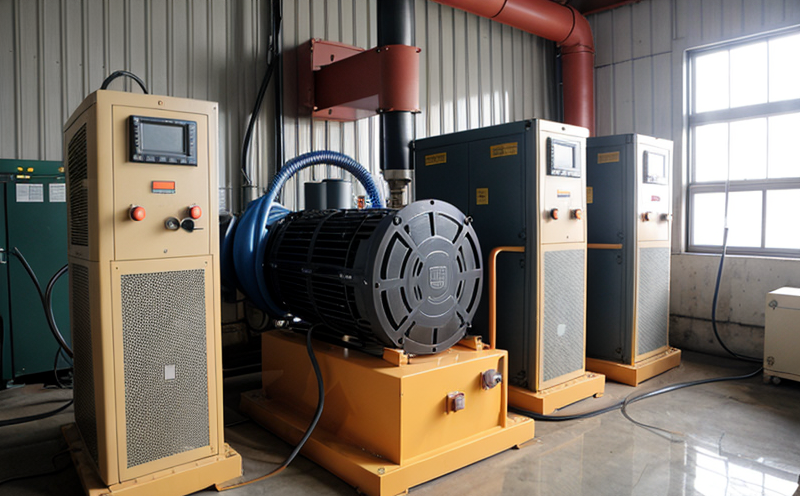ASTM E164 Ultrasonic Testing of Generator Shafts and Rotors
The ASTM E164 standard specifies the procedures for ultrasonic testing (UT) to inspect generator shafts and rotors. This service is critical in ensuring the integrity, reliability, and safety of power generation equipment within the Power & Utilities sector. The focus on these components is paramount due to their role in generating electricity, making them susceptible to wear and tear under high stress conditions.
The UT process involves directing high-frequency sound waves into the material being inspected. These sound waves are reflected back when they encounter a defect or change in density within the metal structure of the shaft or rotor. By analyzing these echoes, technicians can determine the presence, location, orientation, and extent of flaws such as cracks, voids, and other anomalies.
Generator shafts and rotors are essential components of power generation systems. They rotate to convert mechanical energy into electrical energy via electromagnetic induction in a generator. The integrity of these parts is vital for efficient operation and safety, which makes UT an indispensable tool for quality control and maintenance.
The ASTM E164 standard ensures that the ultrasonic testing process adheres to specific parameters. These include the use of appropriate probe angles, frequencies, and coupling agents to optimize detection capabilities. The testing procedure also involves calibrating the equipment against known reference standards to ensure accuracy in defect identification.
Sample preparation for this service typically involves ensuring the surface is clean and free from contaminants that could affect test results. Calibration of the ultrasonic testing equipment must be performed using a standardized procedure before any inspection can begin.
| Parameter | Description |
|---|---|
| Frequency Range | Between 2.5 MHz and 5 MHz, depending on the size of the component. |
| Probe Angle | Selected based on the geometry and material properties of the shaft or rotor. |
| Coupling Agent | A liquid that ensures efficient transmission of sound waves between the probe and the surface being tested. |
| Data Acquisition | Includes recording echoes, signals, and images for comprehensive analysis. |
After testing, a detailed report is generated. This report includes information about the inspection parameters used, the results obtained, and any defects found along with their specifications. The report serves as an essential document for maintaining equipment integrity and compliance with industry standards.
Quality managers and compliance officers can leverage this service to ensure that power generation equipment meets stringent safety and performance criteria. This is particularly important in sectors where downtime can be costly or dangerous, such as the Power & Utilities sector.
R&D engineers benefit from this service by gaining insights into potential failures and areas for improvement in design and manufacturing processes. Procurement teams also find value in ensuring that the equipment they source meets the required quality standards before installation.
Applied Standards
The ASTM E164 standard is widely recognized within the power generation industry as a key reference for ultrasonic testing of generator shafts and rotors. Compliance with this standard ensures that inspections are conducted in a manner consistent with international best practices.
- ASTM E164 provides detailed guidelines on probe selection, frequency range, coupling agents, and calibration procedures.
- The standard specifies the use of ultrasonic testing to detect defects in critical components that could compromise operational safety and efficiency.
- It also outlines the importance of maintaining accurate records for future reference and regulatory compliance.
The application of ASTM E164 is essential for ensuring that inspections are thorough, reliable, and repeatable. This standardization facilitates communication between testing personnel and stakeholders, enhancing overall confidence in the quality and safety of power generation equipment.
Industry Applications
The ASTM E164 ultrasonic testing service is particularly relevant for various applications within the Power & Utilities sector. This includes inspecting generator shafts and rotors in large-scale power plants, wind turbines, and other renewable energy sources.
- Precise Detection of Defects: The service allows for the detection of internal cracks, surface flaws, and other defects that could lead to catastrophic failures if left undetected.
- Maintenance Optimization: By identifying potential issues early on, maintenance schedules can be optimized, reducing downtime and operational costs.
- Safety Assurance: Ensuring the integrity of critical components enhances overall safety in power generation facilities.
| Component | Defect Type | Detection Method |
|---|---|---|
| Generator Shaft | Critical Crack | Ultrasonic Testing |
| Rotor | Surface Abrasion | Ultrasonic Testing |
The service is also beneficial for quality assurance and quality control (QA/QC), ensuring that the materials and processes used in manufacturing meet the highest standards. This can lead to a reduction in rework, scrap, and warranty claims.
International Acceptance and Recognition
The ASTM E164 standard has gained widespread acceptance and recognition across numerous countries and regions within the power generation sector. Its rigorous protocols and consistent outcomes make it a preferred choice for inspections of generator shafts and rotors.
Countries like Australia, New Zealand, and various European nations have incorporated ASTM E164 into their national standards, emphasizing its importance in ensuring the reliability and safety of power generation equipment. In North America, this standard is frequently referenced by regulatory bodies to ensure compliance with local codes.
International acceptance of ASTM E164 extends beyond just inspections; it also influences the design and manufacturing processes for these components. By adhering to this standard, manufacturers can demonstrate their commitment to quality and safety, thereby enhancing their global reputation.





